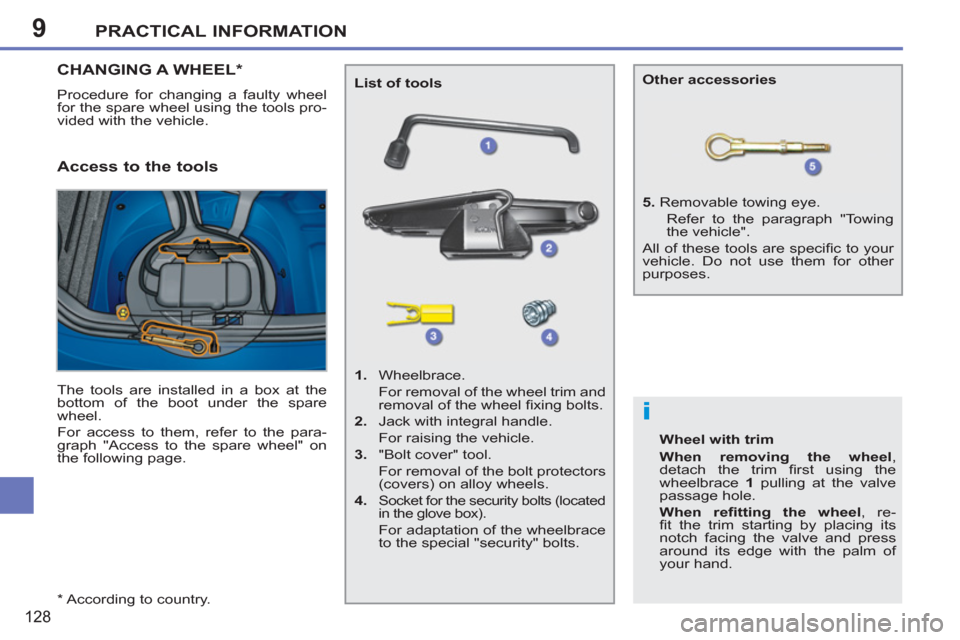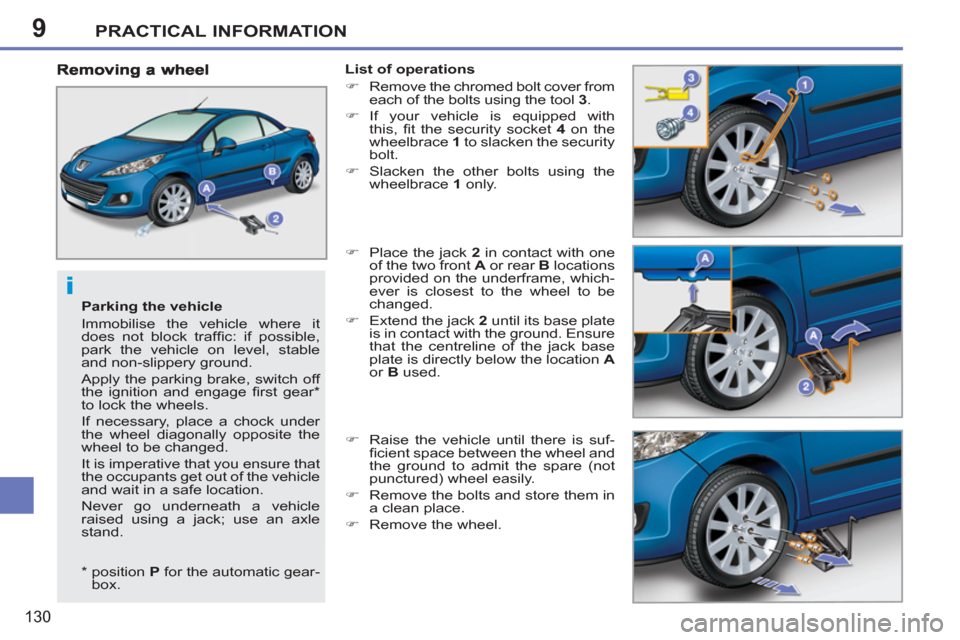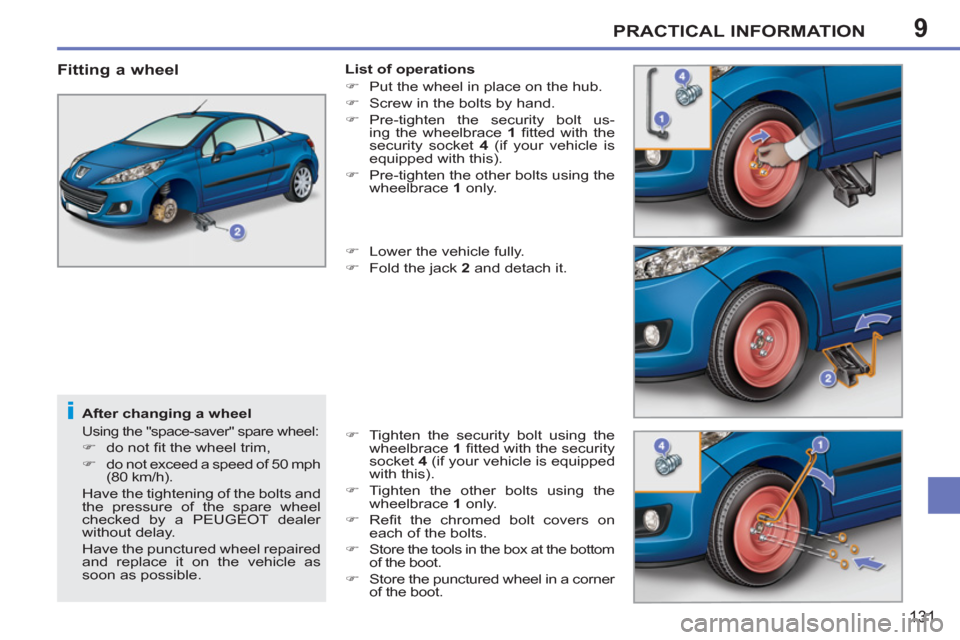2012 Peugeot 207 CC spare wheel
[x] Cancel search: spare wheelPage 21 of 224

19
Limit the causes of excess
consumption
Spread loads throughout the vehicle;
place the heaviest items in the bottom
of the boot, as close as possible to the
rear seats.
Limit the loads carried in the vehicle
and reduce wind resistance (roof bars,
roof rack, bicycle carrier, trailer...). Use
a roof box in preference.
Remove roof bars and roof racks after
use.
At the end of winter, remove snow
tyres and refi t your summer tyres.
Observe the recommendations
on maintenance
Check the tyre pressures regularly,
when cold, referring to the label in the
door aperture, driver's side.
Carry out this check in particular:
- before a long journey,
- at each change of season,
- after a long period out of use.
Don't forget the spare wheel and the
tyres on any trailer or caravan.
Have your vehicle serviced regularly
(engine oil, oil fi lter, air fi lter...) and ob-
serve the schedule of operations rec-
ommended by the manufacturer.
When refuelling, do not continue after
the 3 rd cut-off of the nozzle to avoid
any overfl ow.
At the wheel of your new vehicle,
it is only after the fi rst 1 800 miles
(3 000 kilometres) that you will see
the fuel consumption settle down to a
consistent average.
Page 97 of 224

6
!
i
i
i
SAFETY
95
TYRE UNDER-INFLATION
DETECTION
System which automatically checks the
pressure of the tyres while driving.
All repairs and changing of tyres on
a wheel fi tted with this system must
be carried out by a PEUGEOT
dealer or a qualifi ed workshop.
If, when changing a tyre, you in-
stall a wheel which is not detected
by your vehicle (example: fi tting
of snow tyres), you must have the
system reinitialised by a PEUGEOT
dealer or a qualifi ed workshop.
This system does not eliminate
the need to have the tyre pres-
sure checked regularly (refer to
the "Technical information - Identi-
fi cation markings" page) to ensure
that the optimum dynamic perform-
ance of the vehicle is maintained
and prevent premature wear of the
tyres, particularly in arduous driv-
ing conditions (heavy load, high
speed).
The tyre pressures must be checked
cold, at least once a month. Re-
member to check the pressure of
the spare wheel.
The tyre under-infl ation detection
system may experience temporary
interference due to electro-magnetic
signals on a frequency close to that
used by the system.
Sensors fi tted in each valve trigger a
warning in the event of malfunction. The
speed has to be above 12 mph (20 km/h).
Flat tyre
A message appears in the multifunction
screen, accompanied by an audible sig-
nal, to locate the wheel concerned.
�)
Check the tyre pressures as soon
as possible.
This check must be carried out when
the tyres are cold. This warning lamp and the STOP
warning lamp come on in the in-
strument panel, accompanied by
an audible signal and a message
in the multifunction screen locat-
ing the wheel concerned.
�)
Stop immediately, avoiding any sud-
den movement of the steering wheel
and the brakes.
�)
Change the damaged wheel (punc-
tured or very defl ated tyre), and
have the tyre pressure checked as
soon as possible.
Puncture
The tyre under-infl ation detection
system is an aid to driving which does
not replace the need for the driver to
be vigilant or to drive responsibly.
Sensor(s) not detected or faulty
A message appears in the multifunction
screen, accompanied by an audible sig-
nal, to locate the wheel or wheels which
are not detected or to indicate a fault in
the system.
Contact a PEUGEOT dealer or a quali-
fi ed workshop to replace the faulty
sensor(s).
This message is also displayed
when one of the wheels is away
from the vehicle (being repaired) or
when one or more wheels without a
sensor are fi tted.
The spare wheel is not fi tted with
a sensor.
Page 130 of 224

9
i
PRACTICAL INFORMATION
128
*
According to country.
CHANGING A WHEEL *
Procedure for changing a faulty wheel
for the spare wheel using the tools pro-
vided with the vehicle.
Access to the tools
The tools are installed in a box at the
bottom of the boot under the spare
wheel.
For access to them, refer to the para-
graph "Access to the spare wheel" on
the following page.
List of tools
1.
Wheelbrace.
For removal of the wheel trim and
removal of the wheel fi xing bolts.
2.
Jack with integral handle.
For raising the vehicle.
3.
"Bolt cover" tool.
For removal of the bolt protectors
(covers) on alloy wheels.
4.
Socket for the security bolts (located
in the glove box).
For adaptation of the wheelbrace
to the special "security" bolts.
5.
Removable towing eye.
Refer to the paragraph "Towing
the vehicle".
All of these tools are specifi c to your
vehicle. Do not use them for other
purposes.
Other accessories
Wheel with trim
When removing the wheel
,
detach the trim fi rst using the
wheelbrace 1
pulling at the valve
passage hole.
When refi tting the wheel
, re-
fi t the trim starting by placing its
notch facing the valve and press
around its edge with the palm of
your hand.
Page 131 of 224

9
i
i
PRACTICAL INFORMATION
129
Access to the spare wheel
The "space-saver" spare wheel is in-
stalled in the boot under the fl oor.
To gain access to it:
�)
place the vehicle in the "coupé" con-
fi guration,
�)
open the boot,
�)
raise the fl oor.
Fixing the "space-saver" spare
wheel
If your vehicle is fi tted with alloy
wheels, it is normal to notice, when
tightening the bolts on fi tting, that
the washers do not come into con-
tact with the "space-saver" spare
wheel. The wheel is secured by the
conical contact of each bolt.
Taking out the wheel
�)
Slacken and remove the retaining
strap.
�)
Raise the spare wheel towards you
from the rear.
�)
Take the wheel out of the boot.
Putting the wheel back in place
�)
Put the spare wheel back in its housing.
�)
Put the retaining strap back in place
and tighten it.
�)
Put the boot fl oor back in place.
Tyre under-infl ation detection
The spare wheel is not fi tted with
a sensor. The punctured wheel
must be repaired by a PEUGEOT
dealer.
Page 132 of 224

9
i
PRACTICAL INFORMATION
130
Parking the vehicle
Immobilise the vehicle where it
does not block traffi c: if possible,
park the vehicle on level, stable
and non-slippery ground.
Apply the parking brake, switch off
the ignition and engage fi rst gear *
to lock the wheels.
If necessary, place a chock under
the wheel diagonally opposite the
wheel to be changed.
It is imperative that you ensure that
the occupants get out of the vehicle
and wait in a safe location.
Never go underneath a vehicle
raised using a jack; use an axle
stand.
List of operations
�)
Remove the chromed bolt cover from
each of the bolts using the tool 3
.
�)
If your vehicle is equipped with
this, fi t the security socket 4
on the
wheelbrace 1
to slacken the security
bolt.
�)
Slacken the other bolts using the
wheelbrace 1
only.
�)
Place the jack 2
in contact with one
of the two front A
or rear B
locations
provided on the underframe, which-
ever is closest to the wheel to be
changed.
�)
Extend the jack 2
until its base plate
is in contact with the ground. Ensure
that the centreline of the jack base
plate is directly below the location A
or B
used.
�)
Raise the vehicle until there is suf-
fi cient space between the wheel and
the ground to admit the spare (not
punctured) wheel easily.
�)
Remove the bolts and store them in
a clean place.
�)
Remove the wheel.
* position P
for the automatic gear-
box.
Page 133 of 224

9
i
PRACTICAL INFORMATION
131
After changing a wheel
Using the "space-saver" spare wheel:
�)
do not fi t the wheel trim,
�)
do not exceed a speed of 50 mph
(80 km/h).
Have the tightening of the bolts and
the pressure of the spare wheel
checked by a PEUGEOT dealer
without delay.
Have the punctured wheel repaired
and replace it on the vehicle as
soon as possible.
Fitting a wheel
List of operations
�)
Put the wheel in place on the hub.
�)
Screw in the bolts by hand.
�)
Pre-tighten the security bolt us-
ing the wheelbrace 1
fi tted with the
security socket 4
(if your vehicle is
equipped with this).
�)
Pre-tighten the other bolts using the
wheelbrace 1
only.
�)
Lower the vehicle fully.
�)
Fold the jack 2
and detach it.
�)
Tighten the security bolt using the
wheelbrace 1
fi tted with the security
socket 4
(if your vehicle is equipped
with this).
�)
Tighten the other bolts using the
wheelbrace 1
only.
�)
Refi t the chromed bolt covers on
each of the bolts.
�)
Store the tools in the box at the bottom
of the boot.
�)
Store the punctured wheel in a corner
of the boot.
Page 149 of 224

9
i
!
i
PRACTICAL INFORMATION
147
ACCESSORIES
A wide range of accessories and genu-
ine parts is available from the PEUGEOT
dealer network.
These accessories and parts have been
tested and approved for reliability and
safety.
They are all adapted to your vehicle and
benefi t from PEUGEOT's recommenda-
tion and warranty.
Depending on the legislation in
force in the country, it may be com-
pulsory to have a high visibility
safety vest, warning triangle and
spare bulbs and fuses available in
the vehicle.
The fi tting of electrical equipment or
accessories which are not recom-
mended by PEUGEOT may result
in a failure of your vehicle's elec-
tronic system and excessive electri-
cal consumption.
Please note this precaution. You
are advised to contact a PEUGEOT
representative to be shown the range
of recommended equipment and
accessories.
"Comfort":
door defl ectors, side blinds and rear
blind, coat hanger fi xed to head re-
straint, front centre armrest, under shelf
storage, front and rear parking sen-
sors...
Installation of radio
communication transmitters
Before installing any after-market
radio communication transmitter,
you can contact a PEUGEOT deal-
er for the specifi cation of transmit-
ters which can be fi tted (frequency,
maximum power, aerial position,
specifi c installation requirements),
in line with the Vehicle Electro-
magnetic Compatibility Directive
(2004/104/EC).
"Transport solutions":
boot liner, luggage net, cigarette lighter,
roof bars, bicycle carrier on roof bars,
ski carrier, roof box...
Tow bar, which mst be fi tted by PEUGEOT
dealer or a qualifi ed workshop.
"Styling":
aluminium gear lever knob, spoiler, styling
strips, alloy wheels, trims, chromed mirror
shells, body kit...
*
To avoid any risk of jamming of the
pedals:
- ensure that the mat is positioned
and secured correctly,
- never fi t one mat on top of another.
"Security":
anti-theft alarm, window engraving,
wheel security bolts, child seats and
booster cushions, breathalyzer, fi rst aid
kit, warning triangle, high visibility jacket,
stolen vehicle tracking system, tempo-
rary puncture repair kit, snow chains,
non-slip covers, front foglamps kit...
"Protection":
mats * , seat covers compatible with lateral
airbags, aluminium or PVC door aperture
fi nishers...
"Multimedia":
audio systems, satellite navigation
systems, hands-free kit, CD changer,
speakers, DVD player, connection kit
for MP3 or CD player, USB Box...
You can also obtain products for cleaning
and maintenance (exterior and interior),
topping up (screenwash...),and refi lls
(cartridge for the temporary puncture re-
pair kit...) by visiting a PEUGEOT dealer.
Page 220 of 224

218
ALPHABETICAL INDEX
Screen, colour 16/9..........40,160,181Screen, monochrome.....192,204,206Screen, multifunction (with audioequipment)........................35,37,40Screen, multifunction (without audio equipment)....................................33Screen menu map..........181,204,206Screenwash......................................84Screenwash fluid level....................120Seat adjustment...............................52Seat belts.................................98,100Seats, rear..................................r54,98Serial number, vehicle....................153Service indicator.........................r28,29Servicing...............................18,28,29Setting the clock.............180,202,203Short-cut menus.....................161,162Sidelamps.........................80,132,134Side repeater..................................r132Spare wheel...................................128Speed limiter..................................r110Speedometer....................................r20Stability control (ESP)......................97Starting the vehicle...................67,107Steering mounted controls, audio....191Stopping the vehicle.................67,107Storage.............................................58Sun visor..........................................r57Synchronising the remote control.....67System, navigation.........................163Systems, ASR and ESP...................97
Table of weights......................148, 150Tables of engines...................148, 150Tables of fuses...............................136Tank, fuel....................................77, 79Technical data........................148, 150Telephone...............................177, 178Temperature adjustment.............47, 50Temperature control for heated seats..................................52Temporary tyre repair kit................123Third brake lamp............................134Ticket holder.....................................r58Time..................................................33TMC (Traffic info)............................171Total distance recorder.....................r32Towbar............................................r145Towed loads...........................148, 150To w i ng another vehicle...................144Traction control (ASR)......................97Traffic information (TA).....172,173, 194Traffic information (TMC)........171, 172Trailer.............................................r145Trip computer.............................r42, 43Trip distance recorder......................r32Tyre pressures................................153Tyres.................................................18Tyre under-inflation detection...........95
Warning lamps..................................24Weights...................................148,150Wheel, changing.............................128Wheelbrace....................................128Window controls...............................71Windstop.....................................61,62Wiper control stalk............................84Wipers..............................................84
Ventilation...................................45,46
Under-inflation (detection)................95Unlocking..........................................65Unlocking from the inside.................74Unlocking the boot......................65,76Update risk areas...........................170Updating the date...................202,203Updating the time...................202,203USB (Peugeot Connect).................196
SU
V
T
W